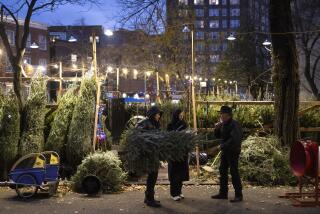Fresh from the box
- Share via
Having killed the living Christmas tree I bought last year, I was confused about how to proceed this holiday season. Could I reconcile my environmentalist leanings with my desire for the ultimate Christmas symbol -- one that represents the hearth and home aspects of the season, not its excessive consumerism?
I didn’t want a living tree again, and not just because of my black thumb. Truth is, I was sort of embarrassed by the diminutive potted pygmy pine I got last year.
An argument could be made that I unconsciously sent it to an early composting because I didn’t want to plant it in my yard. I couldn’t imagine seeing it there every day, especially during the dog days of summer, when visions of sugar plums would be the last thing on my mind.
I was tempted to go back to the farm-grown firs I’d indulged in for years, but that seemed to be a step backward, green-speaking. So I did what I suspect many of my fellow conflicted, Christmas-loving tree huggers have done.
I broke down and bought an imitation tree.
Specifically, I bought an artificial 7 1/2-foot Ohio pine, one that was every bit as full-bodied and lush-looking as the real thing, and even the right shade of green.
I remember that as a kid I felt sorry for friends whose parents were so lazy -- and so tacky -- that they used a sham Christmas tree. I couldn’t imagine returning from school to find a fully decorated fake in the living room. In my mind, those kids were denied a core holiday experience, the afternoon when the whole family bundles up and trots off to the tree lot. They weren’t privy to the comedic hassle of strapping a tree to the car roof, the excited chatter while we drove it home or the group effort required to balance it in a stand in the living room.
A fake tree lacked soul. And it had no smell.
I’d be lying if I said I felt no misgivings at Orchard Supply Hardware as I paid for my imitation pine. There was none of the pomp and circumstance of my youth. I was surrounded not by festive tree buyers but purchasers of nuts, bolts and ladders.
Instead of the roof, my boxed-up tree fit neatly in the trunk.
I warmed up to the tree a bit later that night while balancing my checkbook. The $130 I’d spent was more than I ordinarily paid for the real deal, but it was a one-time cost. Visions of amortization tables danced in my head.
My feelings returned to tepid, however, when I caught sight of all the pieces involved.
Pulling branch after branch out of the box -- my unofficial tally numbered in the dozens -- I began to panic. How long was this assembly going to take? I thought you just propped up a pole, hooked on some branches and started singing carols.And that works -- if you want a sparse, unsatisfying, Charlie Brown sort of tree. But to achieve the fluffy look of the picture on the box requires the skills of a set designer and the patience of a kindergarten teacher. After sorting the branches by length and systematically attaching them to the trunk, I spent three hours fanning out each one of the gazillion fronds on every branch.
A lot goes through your mind during such a mundane task. Two hours into branch-fluffing, I began to doubt my overall mission. Was it really so bad to buy a felled tree? With its thousands of non-biodegradable plastic needles, was my fake tree any better for the environment? Who made this thing, anyway? And where?
I wish I’d investigated the answers earlier. According to the National Christmas Tree Assn. -- yes, there is such a thing -- 89% of fake trees are made in China. Worse, they’re chock-full of lead -- so much that the state of California now requires manufacturers to put warning labels on the box.
Still, fake tree sales have been on the rise in recent years, spurred by the innovation of built-in lights (boy, I wish I’d ponied up the extra $30 for that) and a retro trend toward 1960s-style metallics. But real trees staged a comeback last year too, reversing a long, slow decline.
Whether wood can overtake plastic this year won’t be clear until the last desperate shopper plops down his $65 for a dried out Oregon fir that drops half its needles in the car on Christmas Eve.
But I know where I stand: I regret the synthetic Ohio pine, even if it is the best looking tree I recall ever having. But I’m going to learn to love it. I have to. I’ll be using it for the rest of my life.
Susan Carpenter can be reached at [email protected].






